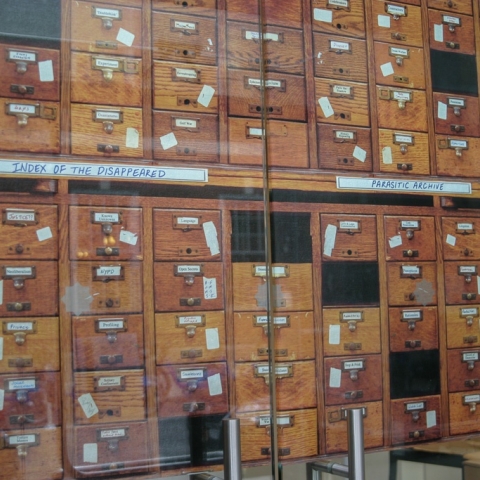Mariam Ghani & Chitra Ganesh
Index of the Disappeared / The radical archive
Public programs, texts, website, installations, 2013-14
Hosted by the NYU Asian/Pacific/American Institute
Events: launch, October 10th, 2013; working group meeting, October 11th, 2013; exhibition opening: February 13th, 2014; archive and window installation opening: April 18th, 2014; conference: April 11th-12th, 2014
Mariam Ghani & Chitra Ganesh have collaborated on the project Index of the Disappeared, a radical archive of post-9/11 polices and their effects, since 2004. By framing archiving as a radical practice, we wish to consider: archives of radical politics and practices; archives that are radical or experimental in form or function; moments or contexts where archiving in itself becomes a radical act; and how archives can be active in the present, as well as documents of the past or scripts for the future.
The Index had an artist residency at the A/P/A institute at NYU for the 2013-14 academic year. During this time, we worked on a series of projects with A/P/A and the broader NYU community, linked by the theme of archiving as a radical practice. The residency began in early October with a talk with Gayatri Gopinath about The Index archive and the idea of "warm data," which we developed for the project . This idea has been taken up by Gopinath and other queer and diasporic theorists as part of larger discussions of the 'archive of feelings.' We then convened a working group meeting with NYU faculty, archivists, and grad students working with archives, along with artists and writers from outside NYU, to help develop ideas for our spring conference, 'Radical Archives'. Based on that meeting we put out an international call for proposals for the conference outlining four major themes:
Archive and Affect
Possible topics could include, but were not limited to: embodied/ performed archives; archive and repertory; buildings as archives; oral and informal histories; private versus public archives, and transitions between those states; warm versus cold data
Archiving Around Absence
Possible topics could include, but were not limited to: disappearing archives; deliberately destroyed archives; inadvertently preserved archives, or unofficial histories within official histories; reading for the shadows; strategies of resistant or counter-archiving
Archives and Ethics
Possible topics could include, but were not limited to: stealing from archives; stealing as the foundation of archives; strategies of refusal or resistance to archiving; ownership of archived testimonies; intellectual property versus intellectual propriety; the afterlives of archives designed for specific purposes, e.g. archives of protests, activist movements, and human rights initiatives; the ethics of open access; FOIA and its discontents
Archive as Constellation
Possible topics could include, but were not limited to: archive as method; the artist's archive; the expanded archival field or notion of the archive; linking of archives across networks; film as archive; subversive or experimental uses of metadata, cataloguing and classification; archive and database, database and interface; how standards and interfaces shape our understanding of collections and the information they contain
We encouraged proposals for a number of different presentation formats, including full panels, individual papers, performances, screenings and hybrid forms. Remarkably, we received about 160 responses to the open call, including a number of full panels.
The responses to the open call were notably diverse, representing a very wide range of possible framings or imaginaries of radical archives. In turn, we felt we had to represent as much of that range as possible within the conference, because making it too narrow would leave out too many important ideas of what a radical archive could be or do. We thus doubled the size we had initially planned (and sadly had to eliminate most travel funding and all speaker fees to do it) and ended up putting on a major international conference, with two ten-hour days of simultaneous programming in two theaters and a gallery.
The conference included keynote speeches by Lara Baladi of Cinema Tahrir, on archiving a revolution in the digital age, Shaina Anand of Pad.ma, on archives and ethics, and Ann Cvetkovich (The Archive of Feelings) on the queer art of the counter-archive. There were 13 panels, 4 performances, 2 durational performances, two media archive viewing stations, an interview project and a screening program. About half the sessions will be podcast on Creative Time Reports, and the video documentation will be uploaded to Pad.ma – which will allow linking to specific time codes within clips, and annotation of clips by participants, as well as embedding of videos on other sites.
For the conference, Ed Potter and I built the website radicalarchives.net, which is intended to grow over the next year (as the various forms of documentation accumulate, and as participants release their full papers) into a resource for the field – both for teaching and, we hope, as a platform for further networking among and scholarship around radical archives. The website is organized around the four threads used to call for proposals. We are also working with Jack Tchen, the director of A/P/A, to develop a book proposal that would possibly use the same organizational scheme. In the meantime, Ibraaz proposed that I guest-edit one section of the forthcoming anthology Archival Dissonance and include some relevant papers from the conference, which I am currently working on.
There was a tremendous feeling of fellowship and excitement at the conference, which led several people to ask if it could become an annual or biennial event. We suggested that it should become a kind of floating conference, with new organizers and hosts each time, and preferably happening on a different continent or at least in a different region, so that a new set of participants could be included.
As far as our own archive goes, we created three new iterations of it this year. From February to March 2014 we had an exhibition at the A/P/A gallery called Secrets Told, which took the Snowden Leaks as a starting point for an examination of the ramifications and iconographies of mass surveillance by the state; from present operations to historical parallels and to future repercussions. For Secrets Told we experimented with transforming part of the archive into a spider diagram, similar to what we used for our web project The Guantanamo Effect, but made physical on the wall with laser-cut-labeled hanging file folders and chalk lines.
From April to May 2014 we have two more shows on the New York University campus. The first is a Parasitic Archive – a library-within-a-library installation of the entire Index archive, which mixes Index materials with materials sourced from the library's own collection, at the Ettinghausen Library of the Kevorkian Center for Near East Studies. The second is Watch This Space, installed in thirteen storefront windows at the Kimmel Student Center, which traces connections between the uses of surveillance and isolation by the state. In keeping with our year of thinking about and talking to radical archivists and librarians, the title is a tribute to the 'warrant canary' signs posted by some librarians to circumvent gag orders imposed by National Security Letters that request patron records. The signs say "The FBI has never asked us for your records. Watch this space for the removal of this sign."
For more information about The Radical Archive visit the website or the Storify page.
About the artist

Mariam Ghani's research-based practice spans video, installation, performance, photography, and text. Her exhibitions and screenings include the Rotterdam, transmediale, and CPH:DOX film festivals, dOCUMENTA (13) in Kabul and Kassel, MoMA in New York, the National Gallery in DC, and the Sharjah Biennials 10 and 9. Recent texts have been published by Filmmaker, Foreign Policy, Mousse, the Radical History Review, Triple Canopy, Creative Time Reports, and the New York Review of Books blog. Ongoing collaborations include the experimental archive Index of the Disappeared (with Chitra Ganesh), the video series Performed Places (with choreographer Erin Kelly), and the Afghan Films online archive (with pad.ma).
Ghani has been awarded the NYFA, Soros and Freund Fellowships, grants from the Graham Foundation, CEC ArtsLink, the Mid-Atlantic Arts Foundation and the Experimental Television Center, and residencies at LMCC, Eyebeam Atelier, Smack Mellon and the Akademie Schloss Solitude. Ghani holds a B.A. in Comparative Literature from NYU and an MFA from SVA. She currently teaches at Pratt and is an artist in residence at the Asian/Pacific/American Institute at NYU.
